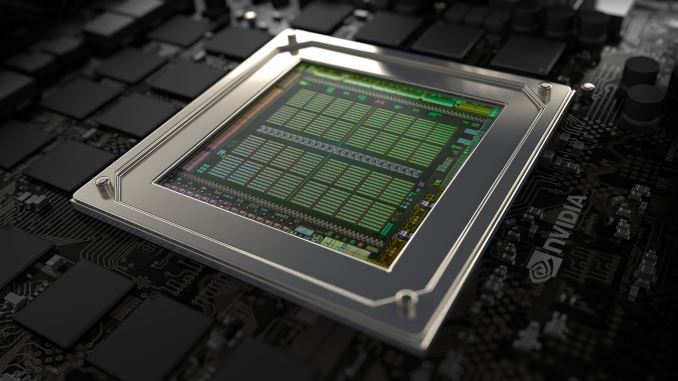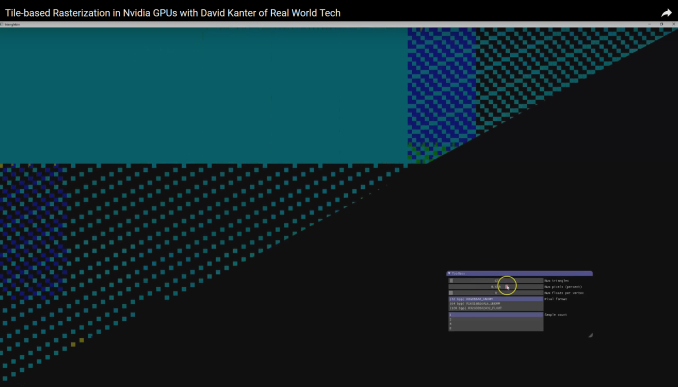Hidden Secrets: Investigation Shows That NVIDIA GPUs Implement Tile Based Rasterization for Greater Efficiency
by Ryan Smith on August 1, 2016 5:00 AM EST
As someone who analyzes GPUs for a living, one of the more vexing things in my life has been NVIDIA’s Maxwell architecture. The company’s 28nm refresh offered a huge performance-per-watt increase for only a modest die size increase, essentially allowing NVIDIA to offer a full generation’s performance improvement without a corresponding manufacturing improvement. We’ve had architectural updates on the same node before, but never anything quite like Maxwell.
The vexing aspect to me has been that while NVIDIA shared some details about how they improved Maxwell’s efficiency over Kepler, they have never disclosed all of the major improvements under the hood. We know, for example, that Maxwell implemented a significantly altered SM structure that was easier to reach peak utilization on, and thanks to its partitioning wasted much less power on interconnects. We also know that NVIDIA significantly increased the L2 cache size and did a number of low-level (transistor level) optimizations to the design. But NVIDIA has also held back information – the technical advantages that are their secret sauce – so I’ve never had a complete picture of how Maxwell compares to Kepler.
For a while now, a number of people have suspected that one of the ingredients of that secret sauce was that NVIDIA had applied some mobile power efficiency technologies to Maxwell. It was, after all, their original mobile-first GPU architecture, and now we have some data to back that up. Friend of AnandTech and all around tech guru David Kanter of Real World Tech has gone digging through Maxwell/Pascal, and in an article & video published this morning, he outlines how he has uncovered very convincing evidence that NVIDIA implemented a tile based rendering system with Maxwell.
In short, by playing around with some DirectX code specifically designed to look at triangle rasterization, he has come up with some solid evidence that NVIDIA’s handling of tringles has significantly changed since Kepler, and that their current method of triangle handling is consistent with a tile based renderer.

NVIDIA Maxwell Architecture Rasterization Tiling Pattern (Image Courtesy: Real World Tech)
Tile based rendering is something we’ve seen for some time in the mobile space, with both Imagination PowerVR and ARM Mali implementing it. The significance of tiling is that by splitting a scene up into tiles, tiles can be rasterized piece by piece by the GPU almost entirely on die, as opposed to the more memory (and power) intensive process of rasterizing the entire frame at once via immediate mode rendering. The trade-off with tiling, and why it’s a bit surprising to see it here, is that the PC legacy is immediate mode rendering, and this is still how most applications expect PC GPUs to work. So to implement tile based rasterization on Maxwell means that NVIDIA has found a practical means to overcome the drawbacks of the method and the potential compatibility issues.
In any case, Real Word Tech’s article goes into greater detail about what’s going on, so I won’t spoil it further. But with this information in hand, we now have a more complete picture of how Maxwell (and Pascal) work, and consequently how NVIDIA was able to improve over Kepler by so much. Finally, at this point in time Real World Tech believes that NVIDIA is the only PC GPU manufacturer to use tile based rasterization, which also helps to explain some of NVIDIA’s current advantages over Intel’s and AMD’s GPU architectures, and gives us an idea of what we may see them do in the future.
Source: Real World Tech










191 Comments
View All Comments
Yojimbo - Monday, August 1, 2016 - link
On Wikipedia it says that PowerVR uses tile-based deferred rendering. NVIDIA is using tile-based immediate rendering, which Wikipedia says Mali and Adreno also use.From what I read there were previously image quality issues with tile-based solutions on the desktop before.
Alexvrb - Monday, August 1, 2016 - link
Well there's different tile based rendering implementations. PVR's tile based differed rendering was the original on the desktop. I can't recall any IQ problems with their TBDR cards, and I owned two of them. In fact they produced really superb quality. They did have some limitations, but it wasn't due to the TBDR design itself. Anyway Nvidia is using immediate TBR instead of deferred. They each have their advantages but immediate is the safer/easier path in terms of compatibility and design. It also theoretically allows them to have a GPU that can use TBIR OR conventional IMR. Which may be something they could decide on a per-game basis.Alexvrb - Monday, August 1, 2016 - link
Deferred* ack. Anyway has anyone looked at the Series7XT Plus yet? I hope that gets more design wins... they nearly doubled the FLOPS vs the 7XT per cluster. If someone built a 16 cluster variant (a GT7900 Plus) for large tablet/hybrid use it could put out ~2TFLOPs at a 1Ghz clock. I'm no fan of Apple but an iPad Pro 2 with 12+ clusters of the Plus would be interesting from a technical standpoint.StrangerGuy - Monday, August 1, 2016 - link
Computing history is filled with less performing products as market victors.So your point is...?
nagi603 - Monday, August 1, 2016 - link
Didn't Carmac say that tile-based solutions are the worst you could do in terms of VR?BrokenCrayons - Monday, August 1, 2016 - link
Possibly, but he's basically been Facebook's spokesperson for the Rift since he left Bethesda after accepting the golden toilet seat that only a company like Zuckerberg's could realistically offer someone who hasn't been doing anything in the industry for years aside from riding on the fame of a few decades old games. Oddly enough, NV's Maxwell cards are standard bearers for VR capability in spite of AMD's efforts to promote their last generation products as VR bliss.However, given both of the GPU companies aren't really trumpeting VR with this new generation of cards and the game releases thus far are essentially casual and indie titles (including releases like IKEA's kitchen designer) I think VR's current resurrection has already run its course and is losing a lot of momentum.
Anyway, my point is not to take the words of a single, barely relevant has-been programmer as gospel. If anything, that guy is hardly worth the worship these days.
Michael Bay - Monday, August 1, 2016 - link
>hasn't been doing anything in the industry for yearsYou mistyped Sweeney.
BrokenCrayons - Monday, August 1, 2016 - link
Sweeney...now there's a name I haven't seen in a good decade, maybe more. When I was running a little mom n' pop computer store in the late 90's and early 00's there were a couple of college student customers of ours that idolized that guy. They sunk a lot of money into our store, so their fervor was something I could overlook while listening to the cash drawer's bell.kn00tcn - Monday, August 1, 2016 - link
you didnt hear him last week talking about MS trying to kill win32?Alexvrb - Monday, August 1, 2016 - link
Yeah I was just gonna say he has been very active... he's been whining, crying, pissing, AND moaning. For years. About the Windows Store and related subjects mostly. He just can not stand the thought of not having a near-monopoly on PC game downloads. I use Steam all the time but jeez man give it a rest. Apple and Google have stores, it's kind of required these days.Plus it's a great way to get family to download apps safely on their fancy touch laptops and tablets. "Just get it from the Store. Yes the little shopping bag icon. Type in Netflix."